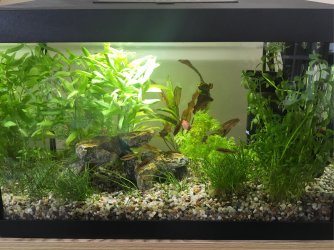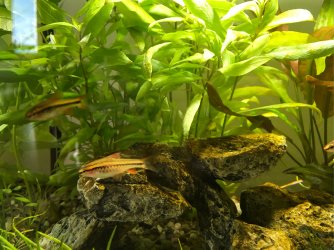freezepops
New Member
- Joined
- Apr 28, 2018
- Messages
- 8
- Reaction score
- 0
Hello.
Tank setup: Mums 25 litre tank containing 6 cherry barbs.
From the beginning: We had cycled it and done water tests in the Api kit - ammonia, nitrite, nitrate, ph. Added 3 cherry barbs, again testing water regularly and changed water each week. Ammonia and nitrites stayed at 0 with just nitrates rising. Water changed weekly so added 3 more cherry barbs. Everything seemed to be going okay and ammonia and nitrites staying at 0 with nitrates sitting at 10.
Yesterday changed 30% water - more than I meant to with her gravel cleaner- added the water back in with dechlorinator. A few hours later out the light on and the fish seemed still and lifeless, I figured maybe I had changed too much water. This morning our male is showing signs of serious illness - lying on side -can’t swim -gasping.
Checked water - ammonia 0, nitrite 0, nitrate 0, ph8.8.
I remember before we added fish ph was neutral, and was neutral before we added the next 3 fish. however I didn’t test ph before I changed water yesterday. Tap water is ph 6.6, dechlorinator is 7. The tank has 8live plants. After googling all morning my understanding is plants raise the ph.
Any ideas if this is ph shock, osmostic shock, and more importantly how do I make my fish better? Are there more tests I can do? I don’t have a general hardiness test or KH test. I also don’t have an oxygen stone/pump - I figured I didn’t need it with live plants. Also do I leave light on or off?
Tank setup: Mums 25 litre tank containing 6 cherry barbs.
From the beginning: We had cycled it and done water tests in the Api kit - ammonia, nitrite, nitrate, ph. Added 3 cherry barbs, again testing water regularly and changed water each week. Ammonia and nitrites stayed at 0 with just nitrates rising. Water changed weekly so added 3 more cherry barbs. Everything seemed to be going okay and ammonia and nitrites staying at 0 with nitrates sitting at 10.
Yesterday changed 30% water - more than I meant to with her gravel cleaner- added the water back in with dechlorinator. A few hours later out the light on and the fish seemed still and lifeless, I figured maybe I had changed too much water. This morning our male is showing signs of serious illness - lying on side -can’t swim -gasping.
Checked water - ammonia 0, nitrite 0, nitrate 0, ph8.8.
I remember before we added fish ph was neutral, and was neutral before we added the next 3 fish. however I didn’t test ph before I changed water yesterday. Tap water is ph 6.6, dechlorinator is 7. The tank has 8live plants. After googling all morning my understanding is plants raise the ph.
Any ideas if this is ph shock, osmostic shock, and more importantly how do I make my fish better? Are there more tests I can do? I don’t have a general hardiness test or KH test. I also don’t have an oxygen stone/pump - I figured I didn’t need it with live plants. Also do I leave light on or off?




